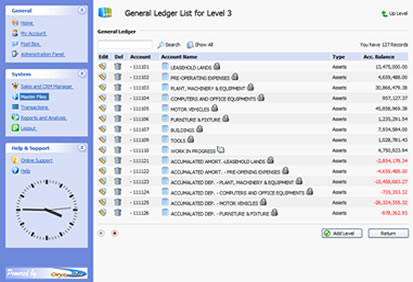Oryx Finance Management
General Ledger
 Financial accounting module of an ERP package provides company wide control and integration of financial information. This module provides the ability to centrally track financial accounting data within a framework of multiple companies, languages and currencies.
The General Ledger (GL) module is the heart of finance package of an ERP system. Through integration with logistics, business processes as well as with accounting sub ledgers of other finance modules such as accounts payable, accounts receivable, cash management, GL provides a central pool of accounting data required for finance reporting (including statutory reports) and other purpose. One of the important functions of GL is to real time update of sub ledger, thus eliminating the time consuming reconciliation. GL also provides summarized data for use in planning, control and reporting.
The important components of GL are:
Financial accounting module of an ERP package provides company wide control and integration of financial information. This module provides the ability to centrally track financial accounting data within a framework of multiple companies, languages and currencies.
The General Ledger (GL) module is the heart of finance package of an ERP system. Through integration with logistics, business processes as well as with accounting sub ledgers of other finance modules such as accounts payable, accounts receivable, cash management, GL provides a central pool of accounting data required for finance reporting (including statutory reports) and other purpose. One of the important functions of GL is to real time update of sub ledger, thus eliminating the time consuming reconciliation. GL also provides summarized data for use in planning, control and reporting.
The important components of GL are:
> GL master data set up.
> GL integration set up with logistics modules.
Integration with other modules: Some of the modules, integrated with GL are:
1.Accounts payable for purchase , credit notes - Groups link.
2.Accounts receivable for sales invoice, credit notes - Groups link.
3.Cash management wherefrom payment details are transferred to GL.
4.Asset management for transferring depreciation details.
5.Cost accounting for allocation of cost.
GL master data set up:
One of the important processes of GL is setting up chart of Accounts, which is a complete structure of ledger accounts used by the organization. Chart of Accounts can be flexibly structured both at a parent and individual company level. Chart of Account may also be defined separately for statutory purpose as well as well as for the purpose of reporting to management. In some packages, the concept of dimension is used which gives a vertical view on ledger account. Another important parameter of GL is transaction type which identifies different categories of transactions such as journal voucher, sales invoice, cash, and corrections. Other important parameters of GL are i) company parameters (this will contain accounts for profit and loss.GL integration set up with logistics modules:
GL integration set up with logistics modules: Integration mapping scheme needs to be defined for posting of logistics transactions into finance. Examples of logistics transactions (for different transaction origins) that result in a corresponding financial transaction and for which corresponding chart of accounts are needed to be defined, are given below:1.Purchases
2.Sales
3.Damages stock options
4.Issues as Expenses or Assets
5.Production
6.Cost center
7.Cycle Counting
